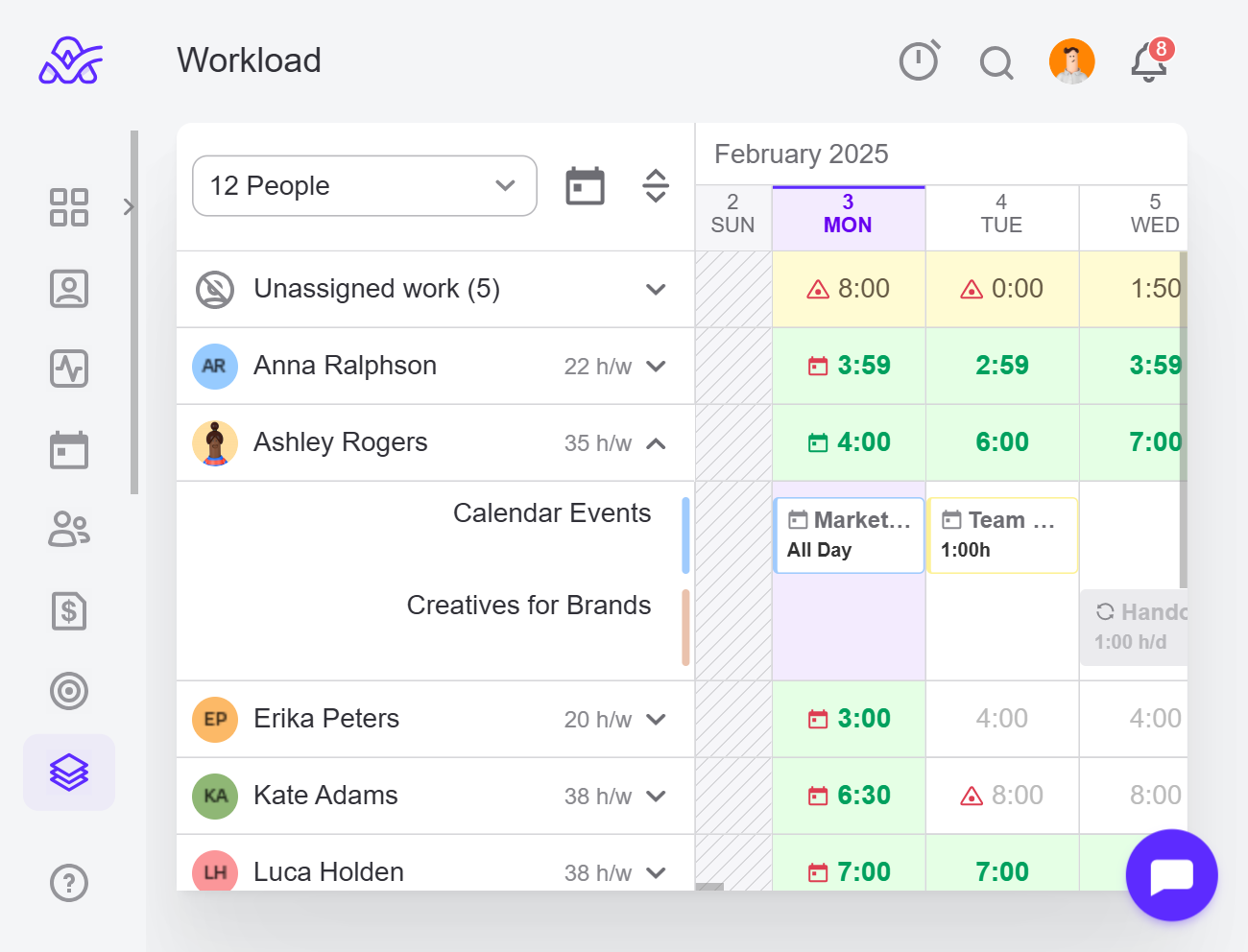Did you know that an average employee spends 11.3 hours in meetings each week? There are also other events, like webinars, online training, all-day conferences..
We often overlook these, the same way we ignore the fact it takes us about 23 minutes to recover and regain focus after a distraction. This affects our productivity, mental capacity, as well as our availability.
ActiveCollab helps you alleviate this. Now, when you create events in your ActiveCollab Calendar, you can add them to participants’ workload.
Let’s see what this means for you.
Improved capacity planning and workload management
When you know how much time your team members have available each day, you can then better distribute tasks and plan capacity. This allows you to optimize utilization rates, increase productivity, and prevent burnout.
However, tracking time spent on billable work isn’t enough.
You also need to know how you’re standing with non-billable hours, so you can get a more accurate picture of your team’s schedule.
In addition to time tracking and time estimates, for more efficient and capacity planning and workload management, you need to include events.
When you create or import daily or all-day events to your ActiveCollab Calendar, by adding them to participants’ workload, these events will appear in Workload.

If an event has a specified start and end time, the number of hours will be reduced from the participants’ daily capacity.
All-day events aren’t taken into account when calculating daily capacity, since it’s assumed people will be away for an entire day. However, they will appear as a calendar icon on the day of the event. If an all-day event takes place on a person’s day off, the calendar icon will be in red.
This will enable you to know exactly how much time someone’s got available for the day, so you don’t overburden them with work. Similarly, if someone’s gone for the whole day for an all-day seminar, you’ll know to reassign their tasks to someone else. And, if someone’s got a few hours available, you can then fill that slot with more work, making sure you don’t overdo it (keep your employee utilization rates at about 80%).
A balanced approach to meetings
Calendar Events in Workload help you analyze these events from a different angle, helping you optimize capacity, boost efficiency, and achieve a greater workday balance.
You might notice that your people spend too much time in meetings that could be turned into a written discussion (and ActiveCollab has dedicated sections for this) or a conversation via our in-app chat.
By removing unnecessary meetings, such as calls or too frequent check-ins, you will reduce stress, and make room for real work and mandatory meetings.
For example, if you have a 30-minute daily in the morning (non-billable) + a client call from 1-2pm, this sums up to a total of 1.5 hours in meetings. If your employees have a daily capacity of 7 hours, by subtracting the 1.5 hours spent in meetings, you will get 5.5 hours each of them has got available (minus all other tasks with time estimates already in their Workload).
Ask yourself, are those daily calls a must? Can you turn them into weeklies and save your team 120 minutes a week?
Chances are, these dailies aren’t the only non-billable meetings or events they have. You can’t expect your team to perform at their full capacity with too many distractions. Besides, unless absolutely necessary, these meetings will cost you money.
Think strategically to decide which internal events are non-negotiable. Learning and development, planning, feedback sessions, these are all useful, both short and long term. On the other hand, meetings without specific goals, taking place more often for no reason, will only drain your team’s energy and eat up their time.
Adjusted client rates and clearer strategic decisions
Many creative agencies don’t charge their clients for meetings. This is wrong. Meetings are one of the ways you provide value, and the hours you and your team spend in client meetings should be billed.
By examining events in your Workload, you will see how much of your team’s daily capacity is taken up by client meetings.
Using the timer to track time more efficiently, you will know if these meetings take longer than expected—and invoice accordingly.
Say your SLA documents one weekly meeting with your client. However, they seem to be pretty curious, so they schedule two more one-hour calls with your team. These could cost you hundreds of dollars.
If you meticulously add all those meetings to your ActiveCollab Calendar and Workload, you will keep track of unforeseen, time-consuming calendar events, which will help you decide on your strategic moves:
Should you revisit your initial SLAs to include additional meeting fees?
Should you charge those meetings extra?
How to proceed if your team is unable to deliver on time due to this?
Do you need to hire more staff to handle customer support?
Adding client meetings to your team’s workload might appear simple, but it’s actually a pretty powerful way to reveal things that might impact both your productivity and your profitability.
Bottom line
Running or working at a creative agency is often too unpredictable and hectic to let seemingly unimportant aspects create more chaos.
You need to think in terms of what’s beneficial for you, your team, and your business goals. This is why it’s crucial that you do your best to track and record your billable and non-billable time.
You can rely on ActiveCollab for that. We’re here to help your business thrive.
